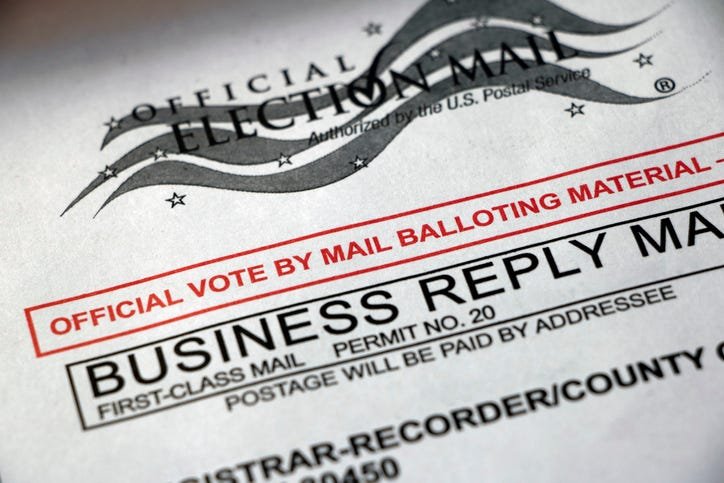Victories in Competitive Races Democratic candidates are securing victories in key races. For instance, Nadarius Clark triumphed in one of Virginia’s most hotly contested seats, exemplifying the party’s strong performance.
Fundraising Advantage Democrats are also seeing a surge in fundraising efforts. While Trump’s donor numbers have declined, Biden’s have increased since 2020. NPR reported that Biden significantly outraised Trump by the end of Q3. However, the gap is narrowing as Trump’s campaign reported a record fundraising haul following his criminal conviction.
Midterm Gains Contrary to grim predictions, the midterms yielded positive results for Democrats. Not only did they retain control of the Senate at the federal level, but they also achieved significant gains in state legislatures nationwide.
Stock Market Trends The stock market’s upward trend is another positive indicator. Historically, when the market rises in the three months preceding an election, the incumbent party tends to win. Current trends suggest this could hold true again.
Democratic Candidates Secure Key Victories in Competitive Races.In recent elections, Democratic candidates have been achieving significant successes in highly competitive races across the United States, demonstrating the party’s strong performance and growing influence. A notable example of this trend is Nadarius Clark’s triumph in one of Virginia’s most fiercely contested seats, a victory that underscores the Democratic Party’s strategic gains and the shifting political landscape.
Nadarius Clark’s Victory in Virginia. Nadarius Clark’s win in Virginia has been a highlight of the recent electoral cycle. Running in a district known for its competitive nature, Clark’s campaign managed to galvanize a diverse coalition of voters, reflecting the Democratic Party’s ability to appeal to a broad spectrum of the electorate. His success is not only a personal achievement but also a strategic victory for the party, as it seeks to consolidate power in key regions ahead of upcoming elections.
Clark’s campaign focused on issues resonant with the local electorate, such as economic development, healthcare access, and educational opportunities. By addressing these core concerns, Clark was able to connect with voters on a personal level, translating into a robust voter turnout and ultimately, his electoral success. His victory is indicative of a larger trend where Democratic candidates are effectively addressing local issues while also aligning with national party goals, thereby enhancing their appeal.
Democratic Gains Across the Board. Clark’s win is part of a broader pattern of Democratic successes in competitive races. Across the nation, Democratic candidates have been securing victories in districts previously considered toss-ups or even leaning Republican. This trend is particularly evident in suburban areas, where shifting demographics and changing political attitudes are creating new opportunities for the party.
These victories are often the result of well-organized grassroots campaigns, effective voter outreach, and a strong emphasis on policy issues that matter to constituents. Democratic candidates are increasingly successful in framing their platforms around healthcare, climate change, and social justice, issues that are gaining traction among a more diverse and younger voter base.
Implications for Future Elections. The string of Democratic victories in competitive races has significant implications for future elections. Firstly, it highlights the party’s growing capability to win in diverse and challenging districts, suggesting a more adaptable and resilient electoral strategy. Secondly, these wins can potentially shift the balance of power in key legislative bodies, influencing policy-making and governance at both state and national levels.
Furthermore, the success of candidates like Nadarius Clark serves as an inspiration for other Democratic hopefuls, demonstrating that with the right approach, it is possible to secure wins even in traditionally competitive areas. This momentum is likely to energize the party base and attract new candidates who see a viable path to victory.
The recent victories of Democratic candidates in competitive races, exemplified by Nadarius Clark’s triumph in Virginia, signal a robust performance by the party. These successes are a testament to the effectiveness of the Democratic electoral strategy and their ability to resonate with a broad electorate. As the political landscape continues to evolve, these wins underscore the party’s potential to influence future elections and shape policy direction, marking a pivotal moment in contemporary American politics.
Democrats Gain Fundraising Edge as Biden Outraises Trump. In the rapidly evolving landscape of American politics, fundraising has become a critical component of electoral success. Recently, Democrats have experienced a notable surge in their fundraising efforts, positioning them advantageously as key elections loom. A significant indicator of this trend is President Joe Biden’s robust fundraising performance, which has surpassed that of former President Donald Trump by the end of the third quarter, according to NPR. However, the fundraising gap between the two political giants is narrowing as Trump’s campaign reported a record haul following his criminal conviction.
Biden’s Fundraising Surge. President Joe Biden’s campaign has seen a remarkable increase in donor numbers and contributions since 2020. This uptick reflects a concerted effort by the Democratic Party to capitalize on Biden’s incumbency and his administration’s legislative accomplishments. By the end of Q3, Biden had significantly outraised Trump, showcasing the effective mobilization of his donor base.
Biden’s fundraising strategy has leveraged a broad network of small-dollar donors alongside substantial contributions from high-profile supporters. The campaign’s ability to attract a diverse array of financial backers highlights Biden’s continued appeal across various demographics. This financial momentum is crucial as it allows the Biden campaign to build a robust war chest for advertising, grassroots mobilization, and other campaign activities essential for maintaining voter engagement and turnout.
Trump’s Resilient Fundraising. Despite a decline in donor numbers following his presidency, Donald Trump’s recent fundraising efforts have shown resilience, particularly in the wake of his criminal conviction. The Trump campaign reported a record fundraising haul post-conviction, signaling a strong rallying effect among his supporters. This surge underscores the loyalty of Trump’s base and their willingness to financially support his comeback bid.
Trump’s fundraising strategy has largely relied on his ability to galvanize his core supporters through direct appeals and a strong presence on social media. His campaign has also benefitted from the perception of being under siege, which has historically driven donations from his most fervent followers. This fundraising boost could narrow the financial gap between Trump and Biden, making the upcoming electoral contest even more competitive.
Strategic Implications for Democrats. The fundraising advantage currently enjoyed by Democrats is more than just a financial cushion; it reflects the party’s broader strategic positioning. With substantial funds at their disposal, Democrats can invest in comprehensive voter outreach programs, sophisticated data analytics for targeted campaigning, and extensive advertising efforts across multiple platforms. This financial edge enables the party to consolidate its gains and potentially expand its influence in key battleground states.
Moreover, Biden’s fundraising success serves as a barometer of his political strength and the effectiveness of his administration’s policies. High fundraising totals often correlate with voter enthusiasm and can translate into higher voter turnout, a critical factor in tightly contested races.
Challenges Ahead and the Narrowing Gap. However, the narrowing gap in fundraising between Biden and Trump indicates that Democrats cannot afford complacency. Trump’s ability to mobilize substantial financial resources, especially following politically charged events, demonstrates the unpredictable nature of the upcoming election cycle. Both parties will need to continuously adapt their fundraising strategies to maintain a competitive edge.
Democrats must also be vigilant in sustaining donor enthusiasm and preventing donor fatigue. Continuous engagement with the donor base, transparent communication about campaign goals, and highlighting legislative achievements will be essential to maintaining and increasing financial support.
The recent surge in fundraising for Democrats, epitomized by President Biden’s significant financial lead over former President Trump by the end of Q3, underscores the party’s current strategic advantage. However, with Trump’s post-conviction fundraising spike narrowing the gap, the financial battle is far from over. As the 2024 election approaches, both parties will need to leverage their fundraising prowess to sway voters and secure electoral victories in what promises to be a fiercely contested political landscape.
Democrats Defy Predictions with Midterm Gains. Contrary to widespread predictions of significant losses, the recent midterm elections yielded unexpectedly positive results for the Democratic Party. Defying the historical trend where the party of the sitting president typically suffers setbacks, Democrats managed not only to retain control of the Senate at the federal level but also achieved notable gains in state legislatures across the nation. This outcome reflects the party’s strategic mobilization and the evolving political dynamics in the United States.
Senate Control Retained. One of the most significant achievements for the Democrats was retaining control of the Senate. Heading into the midterms, many political analysts forecasted a challenging path for the party, given the slim majority they held and the number of seats they had to defend in competitive states. However, through a combination of strong candidate performances, effective campaign strategies, and voter mobilization efforts, Democrats managed to hold their ground.
Key Senate races in battleground states saw Democratic incumbents and challengers outperform expectations. For instance, pivotal wins in states like Pennsylvania and Arizona were instrumental in maintaining the party’s Senate majority. These victories underscore the importance of local issues and candidate quality in determining electoral outcomes, as well as the party’s ability to connect with voters on critical issues such as healthcare, economic stability, and reproductive rights.
State Legislature Gains. Beyond the federal level, Democrats achieved significant gains in state legislatures, which are crucial for shaping policy and governance at the local level. These victories were particularly pronounced in states where the party had been traditionally weaker or where they faced strong Republican opposition.
In states such as Michigan and Pennsylvania, Democrats secured majorities in one or both legislative chambers, breaking long-standing Republican dominance. This shift not only enhances the party’s legislative influence but also has implications for future electoral processes, including redistricting and voting rights legislation. Control of state legislatures enables Democrats to implement policies that reflect their platform and address constituents’ needs more effectively.
Factors Contributing to Success
Several factors contributed to the Democrats’ unexpectedly strong performance in the midterms:
- Effective Mobilization: The party’s grassroots mobilization efforts, including door-to-door canvassing, voter registration drives, and targeted outreach campaigns, played a critical role in driving voter turnout.
- Issue Focus: Democrats successfully framed the midterm elections around key issues such as abortion rights, healthcare access, and economic fairness, resonating with a broad segment of voters.
- Candidate Quality: The selection of strong, locally resonant candidates who could effectively articulate the party’s message and connect with voters on a personal level was instrumental in many races.
- Republican Missteps: Internal divisions within the Republican Party and controversial stances on issues such as abortion and election integrity may have alienated moderate and independent voters, contributing to Democratic gains.
Implications for Future Elections
The midterm gains for Democrats have several implications for future elections:
- Momentum: Retaining control of the Senate and gaining ground in state legislatures provides the party with momentum heading into the next election cycle, bolstering their confidence and strategic position.
- Policy Implementation: With greater legislative control at both federal and state levels, Democrats have an opportunity to advance their policy agenda more effectively, addressing critical issues and delivering on campaign promises.
- Electoral Strategies: The successes of the midterms highlight the importance of grassroots organizing, issue-focused campaigning, and candidate quality, offering valuable lessons for future electoral strategies.
The midterm elections defied grim predictions for the Democratic Party, resulting in significant victories at both the federal and state levels. Retaining control of the Senate and achieving gains in state legislatures reflect the party’s effective mobilization, strategic focus on key issues, and the quality of its candidates. These successes not only bolster the party’s position heading into future elections but also enable it to pursue its policy agenda more vigorously, shaping the political landscape for years to come.
Stock Market Trends Point to Potential Incumbent Party Victory. The stock market’s recent upward trend is another positive indicator for the incumbent party as the election season approaches. Historically, a rising market in the three months leading up to an election has often correlated with a victory for the party currently in power. Current trends suggest that this pattern might hold true once again, providing a boost to the incumbent party’s prospects.
Historical Correlation Between Market Trends and Election Outcomes. Historical data shows a notable correlation between stock market performance and election outcomes. When the stock market experiences gains in the three months preceding an election, it has often been a favorable sign for the incumbent party. This trend is based on the idea that a strong market reflects a robust economy, which in turn suggests voter contentment with the current administration’s economic policies. Conversely, a declining market can signal economic troubles and voter dissatisfaction, often benefiting the challenging party.
Several past elections illustrate this pattern. For instance, the strong market performance leading up to the 2012 presidential election was associated with the re-election of President Barack Obama. Similarly, in 1984, President Ronald Reagan’s re-election coincided with a bullish market. While not an infallible predictor, the stock market’s performance remains a significant barometer of the economic sentiment influencing voter behavior.
Current Market Trends. As the current election approaches, the stock market has been on an upward trajectory. Key indices such as the S&P 500 and the Dow Jones Industrial Average have posted gains, reflecting investor optimism and economic resilience. This trend is especially noteworthy given the various challenges faced by the global economy, including inflationary pressures, supply chain disruptions, and geopolitical tensions.
Several factors have contributed to this positive market trend. Strong corporate earnings reports, advancements in technology and healthcare sectors, and supportive monetary policies from the Federal Reserve have all played a role. Additionally, the gradual resolution of pandemic-related disruptions has bolstered investor confidence, driving market gains.
Implications for the Incumbent Party. The upward trend in the stock market bodes well for the incumbent party as it seeks to retain power. A rising market can be perceived by voters as a sign of economic stability and growth, bolstering the party’s argument for continuity. It suggests that the current administration’s policies are effective in promoting economic health, which is a critical factor for many voters.
Furthermore, positive market performance can enhance consumer confidence, leading to increased spending and investment, further stimulating economic growth. This virtuous cycle can create a favorable environment for the incumbent party, making it easier to campaign on a platform of economic success and stability.
Potential Risks and Considerations. While the current market trend is promising for the incumbent party, it is important to consider potential risks and uncertainties. The stock market can be volatile and influenced by a wide range of factors, including geopolitical events, monetary policy changes, and unexpected economic shocks. A sudden downturn in the market could quickly alter the economic narrative and voter sentiment.
Additionally, while the stock market is a significant economic indicator, it is not the sole determinant of election outcomes. Other factors such as voter turnout, campaign strategies, and key issues like healthcare, education, and social justice also play crucial roles in shaping electoral results.
The stock market’s upward trend provides a positive indicator for the incumbent party as the election approaches, aligning with historical patterns where a rising market has often preceded incumbent victories. This trend reflects investor confidence and economic resilience, bolstering the current administration’s case for continuity. However, the inherent volatility of the market and the multifaceted nature of election dynamics mean that while the stock market is a valuable predictor, it is not the only factor that will determine the election’s outcome. As the election draws nearer, all eyes will be on the market and its potential impact on voter behavior.


